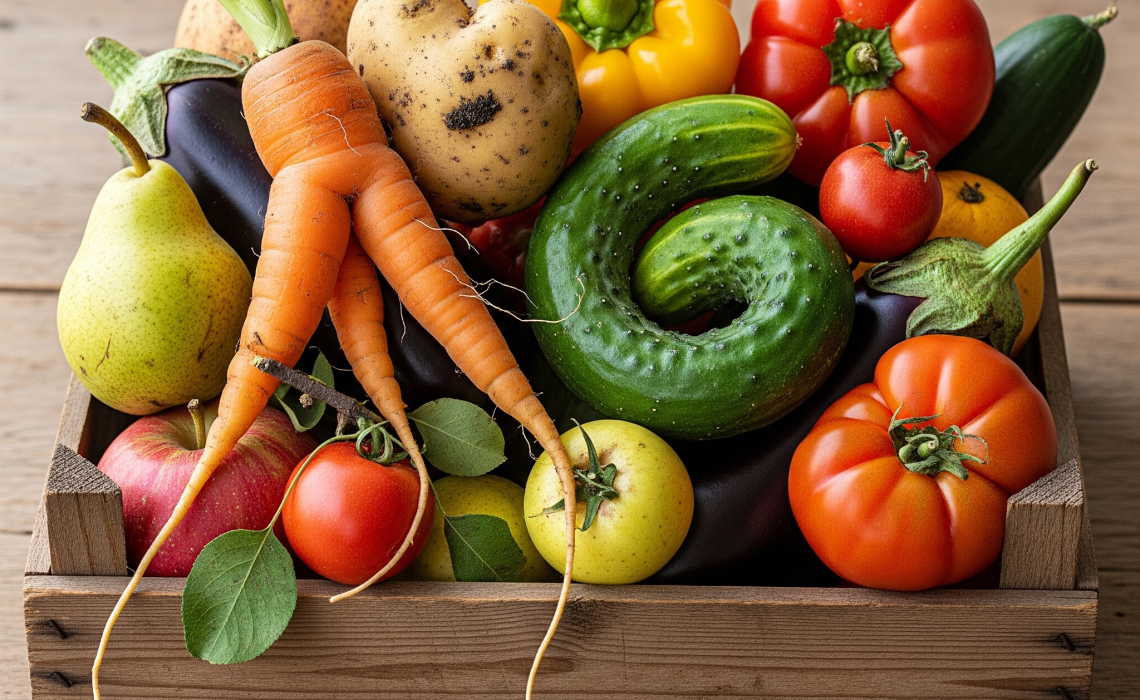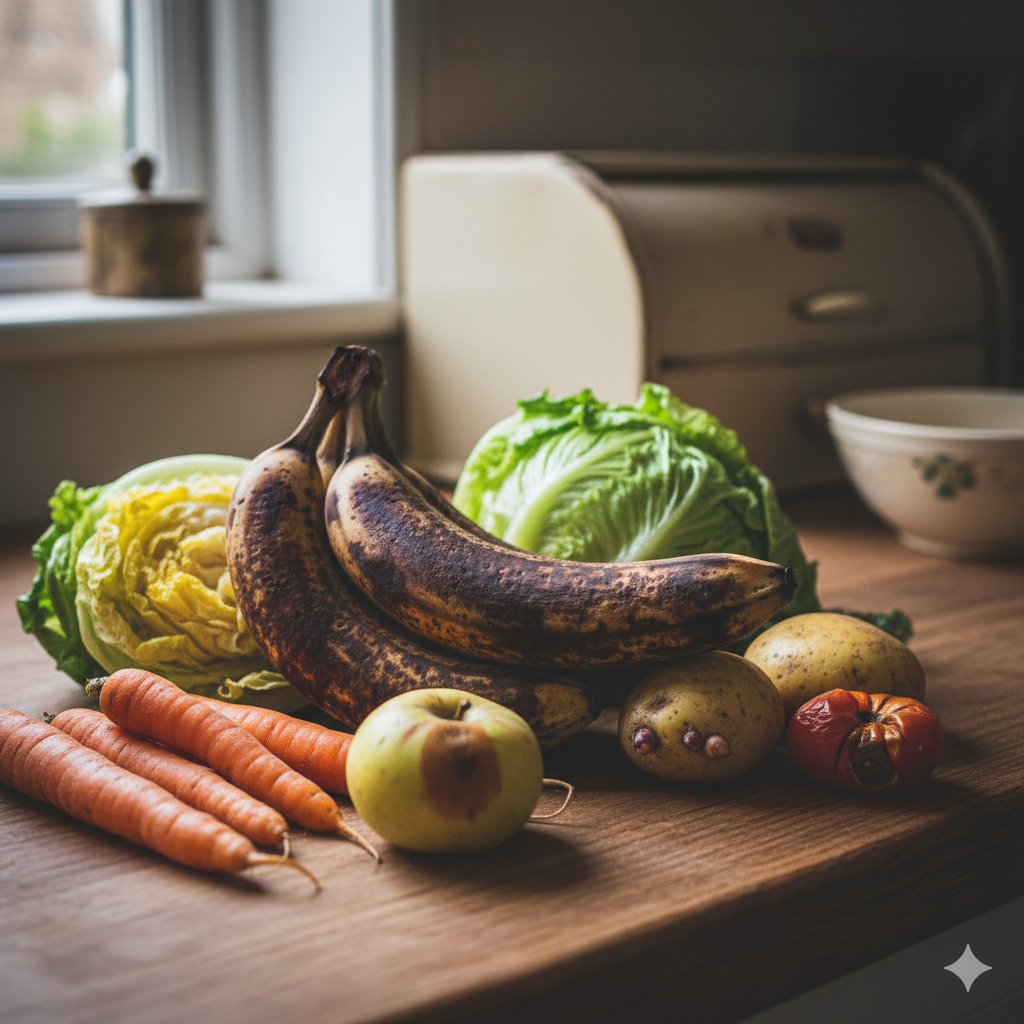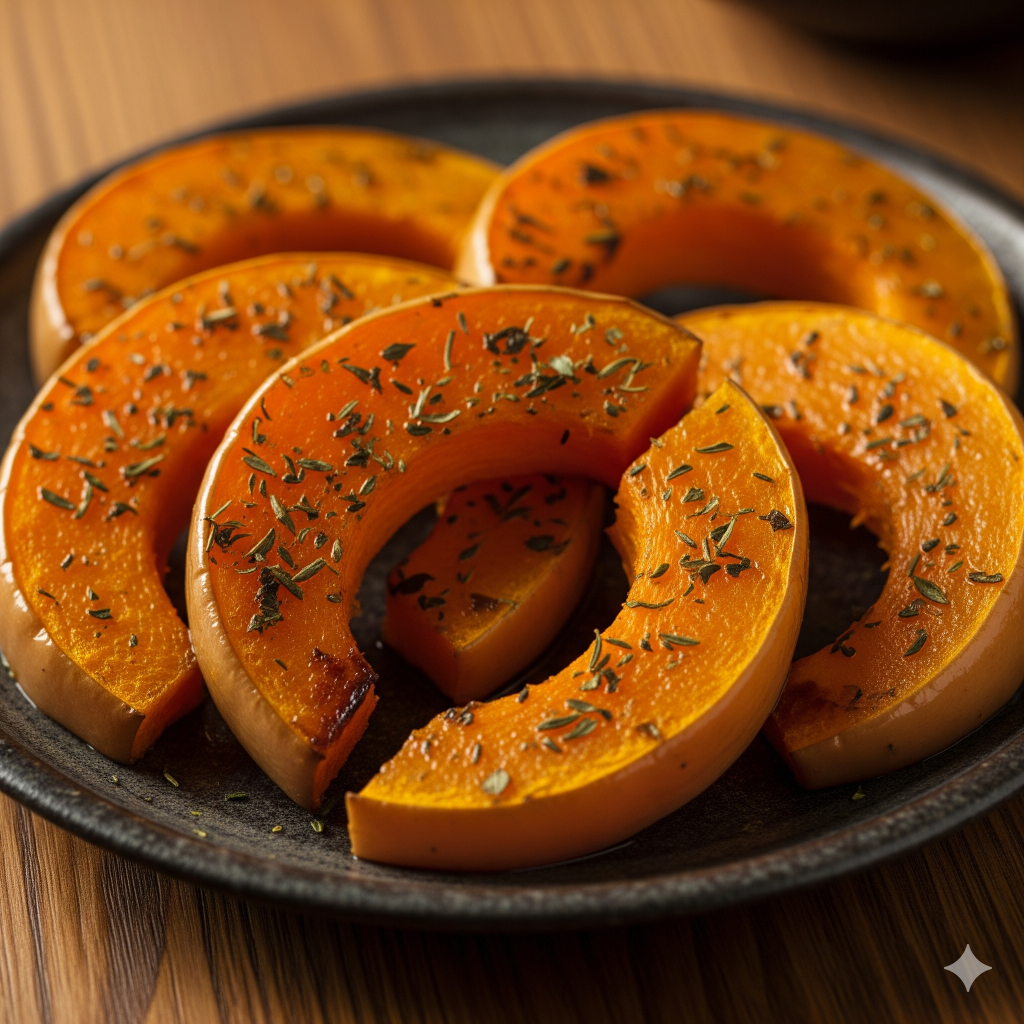
Happy Zero Waste Week! Now, regular readers will know I’m all about making small changes that add up to a big difference for our beautiful planet. It’s not about being perfect, it’s about being thoughtful. And this week is the perfect time to get our thinking caps on about a topic that affects us all: waste. Specifically, food waste.
We’ve all been there, haven’t we? That sad-looking bag of lettuce at the back of the fridge, or the bananas that have gone from yellow to a speckled brown overnight. It’s a bit of a heart sinker, isn’t it? But did you know that the waste we see in our own kitchens is only a tiny part of the story? A staggering amount of food is wasted before it even gets to our plates.
The Invisible Waste
When we think of ‘wasted food’, we often picture what we scrape off our plates or what’s gone off in the fridge. But a huge problem happens long before that. Think about all those ‘wonky’ fruits and vegetables that are deemed too misshapen for supermarket shelves. Perfectly delicious carrots that are a bit too curly, or a courgette that’s not quite straight enough for the pack. These are often left to rot in fields simply because they don’t meet our aesthetic standards. It’s a shocking amount of perfectly good food that never even gets a chance to be eaten.
Then there’s the waste that occurs during processing, transport, and even in shops. Think of the outer leaves of cauliflower and broccoli that are trimmed and thrown away, or the unsold loaves of bread from bakeries. It’s a problem that affects every single stage of the food supply chain. It’s challenging, but there are some things you CAN do – flip to the end to read my ideas.
The Top Culprits
So, what foods are we wasting the most at home? The statistics are pretty eye-opening. According to various reports, the top offenders are often staples in our kitchens:

- Bread and other bakery items: We buy a whole loaf and don’t get through it before it goes stale.
- Fresh fruit and vegetables: These have a short shelf life and are easily forgotten.
- Dairy products: Milk and cheese are often wasted due to their limited lifespan.
- Potatoes: They last a long time, but can sprout or go green if not stored correctly.
- Cooked leftovers: We cook too much and the leftovers sit in the fridge until they’re no longer good to eat.
From ‘Waste’ to Wonderful: Unsung Heroes of the Kitchen
This is where the fun starts! Instead of seeing these as ‘waste’, let’s rethink them as ingredients. There are so many parts of our fruit and veg that we’ve been taught to throw away, but are actually delicious and packed with nutrients.

- Beetroot leaves: These are often chopped off and discarded, but they’re absolutely brilliant. Cook them as you would spinach or chard, or use the tender young ones in a salad. They have a lovely, earthy flavour.
- Butternut Squash Skin: Yes, you can eat it! With a good scrub and a bit of a roast, the skin becomes soft and delicious, saving you the hassle of peeling and adding extra fibre. Just make sure the squash is organic and well-washed.
- Cauliflower and Broccoli leaves: Don’t bin them! The big, outer leaves are wonderful roasted with a little olive oil and salt. They crisp up beautifully, almost like kale chips.
- Carrot Tops: These feathery green tops are not only edible but they can be used like a herb. They have a slightly earthy, carrot-like flavour and can be blended into a pesto, or used to flavour a soup or stock.
- Potato peelings: My goodness, don’t throw these away! Toss them in a little oil and your favourite spices (I love paprika and garlic powder) and roast them until they’re crispy. A perfect, zero-waste snack!
A Quick Word on Potatoes and Sprouts
Potatoes that have started to sprout or have green spots can be eaten, but you need to be careful. The sprouts and green parts contain a natural toxin called solanine. It’s important to cut away and discard the sprouts and any green areas, as these parts have the highest concentration of the toxin. If the potato is soft, shrivelled, or has extensive sprouting, it’s best to throw it out entirely, ideally in your compost bin, to be safe.
Dairy SOS: Don’t Bin It!
Dairy products are a big part of food waste, but there are so many ways to save them!
- Freezing Cheese: Did you know you can freeze most hard and semi-hard cheeses? Shredded or in blocks, cheeses like cheddar, mozzarella, and parmesan freeze brilliantly. It’s best to use defrosted cheese for cooking, as the texture can become a little crumbly.
- Leftover Yogurt and Milk: Don’t let that last bit of yogurt go bad! Blend it with some overripe bananas and other fruit for a delicious and healthy smoothie. A great way to use up milk is to make a white sauce for mac and cheese or a tasty dessert like rice pudding. You can even freeze milk in ice cube trays to add to your coffee or tea.
Freezer Magic: Your Secret Weapon Against Food Waste
The freezer is your best friend when it comes to tackling food waste. It’s like a pause button for your groceries!
- Leftovers: Cooked too much? Portion up the leftovers and freeze them for a quick, homemade ready meal on a busy day.
- Vegetable Scraps: Keep a bag in the freezer for all your peelings and offcuts. When it’s full, throw them in a pot with some herbs and water to make a flavourful vegetable stock.
- Brown Bananas: Chop the flesh into chunks and freeze on an open tray. Whizz them into ‘icecream’ adding raw cocoa powder, maple syrup and some coconut cream for a yummy healthy treat.
- Wilting Herbs: Chop up those fresh herbs that are on their last legs, pop them in an ice cube tray, top with olive oil and freeze. You’ll have perfect little flavour bombs ready to go for your next meal.
- Stale Bread: Don’t let it go mouldy! Slice it up and freeze for toast, or blitz it into breadcrumbs to use later.

Fuelling a Greener Future, One Story at a Time. Every small step we take – from reusable bags to conscious consumption – ripples outwards, creating a wave of hope. Let’s rewrite the story of our planet, one click at a time. I believe in the power of storytelling. By sharing inspiring environmental initiatives, unsung sustainability heroes and practical tips, I aim to amplify the voices making a difference. Imagine a world where everyone is empowered to take action, one small change at a time. ‘Buy Me A Coffee’ donation is a quick and easy way to offer a small, one-off donation, that helps keep this platform running and allows me to continue sharing these vital stories. Just click the “Donate” button (top right corner). Every contribution, no matter the size, makes a difference. Thank you for being a part of this journey.
While much of the “invisible waste” happens at the supply chain level, there are definitely things you can do as a consumer to influence it. Your choices at the supermarket and beyond can directly impact how much food is wasted before it even gets to you.
Voting with Your Wallet: Supporting “Wonky” Produce 🥕
One of the biggest contributors to invisible food waste is the rejection of perfectly good fruits and vegetables for being “ugly” or misshapen. Supermarkets have strict cosmetic standards, leading to billions of pounds of produce being thrown away each year.
- Buy the imperfect ones: When you’re at the shop, seek out the carrots with two legs or the slightly lopsided apples. Some supermarkets now have dedicated sections for “wonky” or “ugly” produce, often sold at a discount. By buying these items, you’re sending a clear message to retailers that you value food for its taste and nutrition, not its appearance. Or switch to organisations such as Oddbox where it’s all about wonky and ugly products.
- Support local farmers’ markets: Farmers often sell a wider variety of produce, including those that wouldn’t make it onto a supermarket shelf. Shopping at these markets helps reduce supply chain waste and supports local businesses directly.
Educate Yourself and Others
Knowledge is power, especially when it comes to food. The more we understand, the more we can advocate for change.
- Understand date labels: There’s a big difference between “use by” and “best before” dates. “Use by” relates to food safety, while “best before” is about quality. A product may be perfectly safe to eat after its “best before” date. This confusion is a major cause of consumer food waste, which in turn affects what retailers order and stock.
- Spread the word: Share what you’ve learned with friends and family. The more people who are aware of this issue, the more pressure there is on the food industry to change its practices.
Advocate for Systemic Change
While individual actions are crucial, a lot of the work to reduce invisible waste must happen on a larger scale.
- Support food redistribution charities: Many charities work to collect surplus food from farms, manufacturers, and retailers and get it to those in need. By supporting these organisations, you help ensure that edible food doesn’t go to waste.
- Encourage businesses to act: You can contact your favourite supermarkets and food brands and ask them what they’re doing to reduce food waste in their supply chains. Many companies are now publishing their sustainability goals, and consumer pressure can help push them to do more.
Rethinking waste isn’t just about saving money, although it does do that brilliantly! It’s about being more mindful of the journey our food takes and honouring the resources that go into producing it. It’s a small way we can all make a difference, one beetroot top and butternut squash skin at a time.
